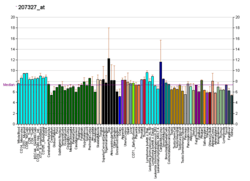EYA4
Eyes absent homolog 4 is a protein that in humans is encoded by the EYA4 gene.[3][4][5]
This gene encodes a member of the eyes absent (EYA) family of proteins. The encoded protein may act as a transcriptional activator and be important for continued function of the mature organ of Corti. Mutations in this gene are associated with postlingual, progressive, autosomal dominant hearing loss at the deafness, autosomal dominant nonsyndromic sensorineural 10 locus. Three transcript variants encoding distinct isoforms have been identified for this gene.[5]
References
- ↑ "Human PubMed Reference:".
- ↑ "Mouse PubMed Reference:".
- ↑ Borsani G, DeGrandi A, Ballabio A, Bulfone A, Bernard L, Banfi S, Gattuso C, Mariani M, Dixon M, Donnai D, Metcalfe K, Winter R, Robertson M, Axton R, Brown A, van Heyningen V, Hanson I (Mar 1999). "EYA4, a novel vertebrate gene related to Drosophila eyes absent". Hum Mol Genet. 8 (1): 11–23. PMID 9887327. doi:10.1093/hmg/8.1.11.
- ↑ Wayne S, Robertson NG, DeClau F, Chen N, Verhoeven K, Prasad S, Tranebjarg L, Morton CC, Ryan AF, Van Camp G, Smith RJ (Feb 2001). "Mutations in the transcriptional activator EYA4 cause late-onset deafness at the DFNA10 locus". Hum Mol Genet. 10 (3): 195–200. PMID 11159937. doi:10.1093/hmg/10.3.195.
- 1 2 "Entrez Gene: EYA4 eyes absent homolog 4 (Drosophila)".
Further reading
- O'Neill ME, Marietta J, Nishimura D, et al. (1996). "A gene for autosomal dominant late-onset progressive non-syndromic hearing loss, DFNA10, maps to chromosome 6". Hum. Mol. Genet. 5 (6): 853–6. PMID 8776603. doi:10.1093/hmg/5.6.853.
- Schönberger J, Levy H, Grünig E, et al. (2000). "Dilated cardiomyopathy and sensorineural hearing loss: a heritable syndrome that maps to 6q23-24". Circulation. 101 (15): 1812–8. PMID 10769282. doi:10.1161/01.cir.101.15.1812.
- Strausberg RL, Feingold EA, Grouse LH, et al. (2003). "Generation and initial analysis of more than 15,000 full-length human and mouse cDNA sequences". Proc. Natl. Acad. Sci. U.S.A. 99 (26): 16899–903. PMC 139241
 . PMID 12477932. doi:10.1073/pnas.242603899.
. PMID 12477932. doi:10.1073/pnas.242603899. - Pfister M, Tóth T, Thiele H, et al. (2004). "A 4-bp insertion in the eya-homologous region (eyaHR) of EYA4 causes hearing impairment in a Hungarian family linked to DFNA10". Mol. Med. 8 (10): 607–11. PMC 2039947
 . PMID 12477971.
. PMID 12477971. - Mungall AJ, Palmer SA, Sims SK, et al. (2003). "The DNA sequence and analysis of human chromosome 6". Nature. 425 (6960): 805–11. PMID 14574404. doi:10.1038/nature02055.
- Gerhard DS, Wagner L, Feingold EA, et al. (2004). "The Status, Quality, and Expansion of the NIH Full-Length cDNA Project: The Mammalian Gene Collection (MGC)". Genome Res. 14 (10B): 2121–7. PMC 528928
 . PMID 15489334. doi:10.1101/gr.2596504.
. PMID 15489334. doi:10.1101/gr.2596504. - Schönberger J, Wang L, Shin JT, et al. (2005). "Mutation in the transcriptional coactivator EYA4 causes dilated cardiomyopathy and sensorineural hearing loss". Nat. Genet. 37 (4): 418–22. PMID 15735644. doi:10.1038/ng1527.
- Kimura K, Wakamatsu A, Suzuki Y, et al. (2006). "Diversification of transcriptional modulation: Large-scale identification and characterization of putative alternative promoters of human genes". Genome Res. 16 (1): 55–65. PMC 1356129
 . PMID 16344560. doi:10.1101/gr.4039406.
. PMID 16344560. doi:10.1101/gr.4039406. - Beausoleil SA, Villén J, Gerber SA, et al. (2006). "A probability-based approach for high-throughput protein phosphorylation analysis and site localization". Nat. Biotechnol. 24 (10): 1285–92. PMID 16964243. doi:10.1038/nbt1240.
- Makishima T, Madeo AC, Brewer CC, et al. (2007). "Nonsyndromic hearing loss DFNA10 and a novel mutation of EYA4: evidence for correlation of normal cardiac phenotype with truncating mutations of the Eya domain". Am. J. Med. Genet. A. 143 (14): 1592–8. PMID 17567890. doi:10.1002/ajmg.a.31793.
- Hildebrand MS, Coman D, Yang T, et al. (2007). "A novel splice site mutation in EYA4 causes DFNA10 hearing loss". Am. J. Med. Genet. A. 143 (14): 1599–604. PMID 17568404. doi:10.1002/ajmg.a.31860.
This article is issued from
Wikipedia.
The text is licensed under Creative Commons - Attribution - Sharealike.
Additional terms may apply for the media files.
